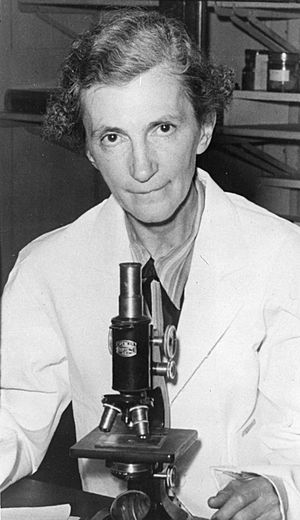Elizabeth C. Crosby facts for kids
Quick facts for kids
Elizabeth Caroline Crosby
|
|
|---|---|

Elizabeth Caroline Crosby sitting in lab with microscope. This photo was distributed in connection with her 1950 award from the American Association of University of Women.
|
|
| Born | October 25, 1888 Petersburg, Michigan
|
| Died | July 28, 1983 (aged 94) |
| Nationality | American |
| Other names | Elizabeth C. Crosby |
| Alma mater | University of Chicago |
| Awards | National Medal of Science, Achievement Award of the American Association of University Women, Henry Gray Award of the American Association of Anatomists |
| Scientific career | |
| Fields | Neuroanatomy, neuroscience, neurosurgery |
| Institutions | University of Alabama Birmingham, University of Michigan Medical School |
| Thesis | The Forebrain of Alligator Mississippiensis (1915) |
| Doctoral advisor | Charles Judson Herrick |
Elizabeth C. Crosby (October 25, 1888 – July 28, 1983) was an American scientist. She was a famous neuroanatomist, which means she studied the structure of the nervous system and the brain.
Elizabeth Crosby was born in Petersburg, Michigan. In 1979, she received the National Medal of Science. This important award was given to her by President Jimmy Carter. She earned it for her amazing work on brains. She studied the brains of many animals, especially reptiles. Her work helped us understand how brains have changed over time. She also helped brain surgeons by connecting brain anatomy with surgery.
Contents
Becoming a Brain Expert
Elizabeth Crosby finished Adrian College in 1910. She earned a Bachelor of Science degree in mathematics. A professor there, Elmer Jones, inspired her to study more.
She then went to the University of Chicago. There, she studied under a famous scientist named C. Judson Herrick. She earned her Masters of Science degree in biology in 1912. Later, in 1915, she received her Ph.D. in anatomy.
Teaching and Research
In 1920, Elizabeth Crosby started teaching at the University of Michigan. She taught classes like histology (the study of tissues) and neuroanatomy. In 1923, she took a break from teaching. She went to Amsterdam to work with another well-known scientist, C. U. Ariëns Kappers.
While in Amsterdam, she helped write a very important book. It was called The Comparative Anatomy of the Nervous System of Vertebrates (1936). Even though she didn't go to medical school, she made history. In 1936, she became the first woman to be a full professor at the University of Michigan Medical School. She also received the university's Faculty Achievement Award in 1956.
Working During Wartime
In 1939, she took another break to work in Scotland. She was with Professor Robert Douglas Lockhart at the University of Aberdeen. However, World War II started. Travel across the Atlantic Ocean became very difficult. Because of this, she had to stay in Scotland until 1941.
Later Career and Recognition
Elizabeth Crosby eventually became a Professor Emeritus of Anatomy. This means she retired but kept her title. She also became a consultant for brain surgeons. In 1963, she left the University of Michigan. She moved to the University of Alabama at Birmingham. There, she again became a Professor Emeritus of Anatomy.
In 1987, she was honored by being added to the Alabama Women's Hall of Fame. Her excellent teaching skills were also recognized. In 1957, the Galens Society at the University of Michigan Medical School created an award in her name. The Elizabeth C. Crosby annual award is given for the best teaching in the early years of medical school.
Awards and Honors
Elizabeth C. Crosby received many awards for her important work:
- 1926: The Solis Award from the University of Michigan.
- 1946: The Henry Russell Lectureship from the University of Michigan.
- 1950: The Achievement Award from the American Association of University Women.
- 1957: The Elizabeth C. Crosby award for best teaching was created in her honor.
- 1970: An Honorary Doctorate of Sciences from the University of Michigan.
- 1972: The Henry Gray Award from the American Association of Anatomists.
- 1980: Distinguished Faculty Lecturer from the University of Alabama Birmingham.
- 1980: The National Medal of Science, presented by President Jimmy Carter.
See also
 In Spanish: Elizabeth C. Crosby para niños
In Spanish: Elizabeth C. Crosby para niños

